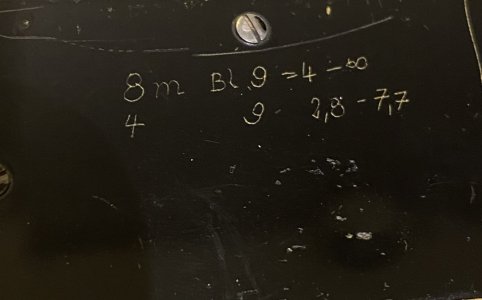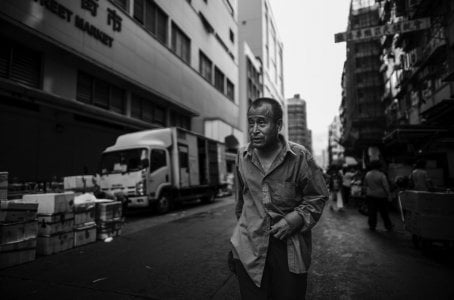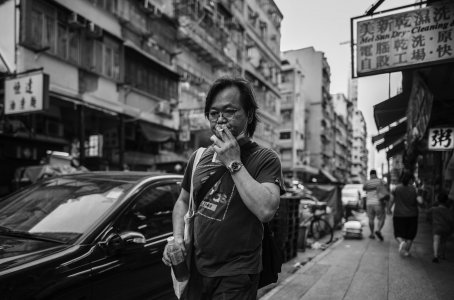Evergreen States
Pierre Saget (they/them)
I will sometimes practice by walking around with a camera and lens and standing at different distances from an object, approximating 1, 2, 3 and 5m. On each drill, I will have preset the focus. I then raise the camera to my eye and check the focus to see how close I got. It helps to do this for a few different lenses that you regularly use so that you can predict not only the focus distance but learn to anticipate how close or far you have to be to fill the frame.
CMur12
Well-known
DOF scales are an approximation. I always err on the side of caution and use the scale for the aperture that is one stop larger than the one in actual use. Also, DOF scales on many FSU lenses sometimes have no connection with reality when compared to the scales of comparable focal length lenses from Japanese or German manufacturers. When they differ, they are usually far too generous.
I do this, also.
I have always had cameras with focusing aids, so I haven't developed distance-estimating skills. I also don't shoot street, so I'm not under pressure to focus very quickly.
That said, with normal focal-length lenses and longer, I focus on an object, so precise focus is important.
With wide-angle lenses (28mm), used for landscapes, I don't focus on an object. Rather, I focus on an area and everything within it. So, I focus these lenses with the DOF scale.
One thing I really miss on modern auto-focus cameras is DOF scales, especially on wide-angle lenses.
- Murray
Richard G
Mentor
This was neatly scratched on the baseplate of my Leica II. Blende is aperture.I remember saving this insight. I also have hard times adjusting/estimating distances with lenses marked meters only vs. feet
A Tip

Retro-Grouch
Well-known
Cool! While I wouldn't advocate doing this sort of thing to a Leica, or any camera, I do appreciate coming across it on used equipment I've purchased. I have several pieces of Hassy equipment engraved with previous owners' names and, sometimes, driver's license numbers; my 50 Distagon is crudely engraved "property of San Jose Mercury News". It connects me with the pieces' histories. So I suppose it's "This was neatly scratched on the baseplate of my Leica II. Blende is aperture.
View attachment 4829202
DownUnder
Nikon Nomad
As so many have said here, zone focusing is the way. For me, it's the best way, and often the only way.
I've been using it since the early 1960s, for almost all my image-making. When I take landscapes or any image requiring reasonable sharpness across the entire three-plane (close, medium, long) focusing range, it's almost always f/8 and +/-15-20 feet (5-6.5 meters). Most of my final images have to be sharpened a little in post-processing, but I do that anyway, to 'harden' the soft focus effect a little.
I notice many here photograph at high (or do I really mean low?) lens settings - f/1.5, f/2, f/2.8. I don't remember the last time I photographed anything at less than f/5.6, but that's me. Others do it their way, which is at it should be. Whichever, zone focusing works well enough to satisfy almost everyone, more or less.
For me it works for both DX and FX in digital. And of course film. The latter is in fact much better for zone focusing as all my older Nikon and Leitz lenses have two sets of f/stops engraved on the lens. My Nikon D lenses don't, so I guess it. I set the distance between the two f/8 settings and as we say here in Oz, Bob's your uncle...
I hope this explanation makes sense. It's actually easier to do than to try to explain.
I've been using it since the early 1960s, for almost all my image-making. When I take landscapes or any image requiring reasonable sharpness across the entire three-plane (close, medium, long) focusing range, it's almost always f/8 and +/-15-20 feet (5-6.5 meters). Most of my final images have to be sharpened a little in post-processing, but I do that anyway, to 'harden' the soft focus effect a little.
I notice many here photograph at high (or do I really mean low?) lens settings - f/1.5, f/2, f/2.8. I don't remember the last time I photographed anything at less than f/5.6, but that's me. Others do it their way, which is at it should be. Whichever, zone focusing works well enough to satisfy almost everyone, more or less.
For me it works for both DX and FX in digital. And of course film. The latter is in fact much better for zone focusing as all my older Nikon and Leitz lenses have two sets of f/stops engraved on the lens. My Nikon D lenses don't, so I guess it. I set the distance between the two f/8 settings and as we say here in Oz, Bob's your uncle...
I hope this explanation makes sense. It's actually easier to do than to try to explain.
Rayt
Nonplayer Character
It’s easier to do street photography and zone at f1.4 if you are using really wide like a 21mm or 24mm. From 5 feet away where the typical street subject should be there is enough dof I think around a foot. Again it is just practice and repeat until it becomes muscle memory. Best to stick with one focal length so you know it well enough to compose with it without the need to look through a finder. M10M 21mm Summilux @1.4 Minimal cropping to straighten out the lines.


Rayt
Nonplayer Character
DownUnder
Nikon Nomad
Rayt,
Your comments noted. But try enlarging one of your f/1.4 images to A4 and see what you get.
This said, I cannot recall the last time I ever printed an A4. So I reckon both our viewpoints rate about the same.
Excellent images, BTW. You have a good eye for the moment. HCB would surely agree...
Your comments noted. But try enlarging one of your f/1.4 images to A4 and see what you get.
This said, I cannot recall the last time I ever printed an A4. So I reckon both our viewpoints rate about the same.
Excellent images, BTW. You have a good eye for the moment. HCB would surely agree...
Rayt
Nonplayer Character
I am cheating a bit on the focus because the shallow dof of the 21mm Summilux blows out the backgrounds masking slight oof on the subject in case I don’t nail it. Also I am a film lover at heart and absolutely abhor the hard edged over sharpened digital look. Even without the film grain I think I am happy with it. It does look like TMY a little.
DownUnder
Nikon Nomad
They are still super good photos. You cannot escape that, however much you try...I am cheating a bit on the focus because the shallow dof of the 21mm Summilux blows out the backgrounds masking slight oof on the subject in case I don’t nail it. Also I am a film lover at heart and absolutely abhor the hard edged over sharpened digital look. Even without the film grain I think I am happy with it. It does look like TMY a little.
Rayt
Nonplayer Character
They are still super good photos. You cannot escape that, however much you try...
Thanks for the encouragement. Both are essentially the same photo different subject. So I have moved on from that. It got stale very quickly. The top one I’ll hang on my wall and the second one was just practice. I don’t want to take the same photo again.
Bingley
Mentor
Zone focusing is a tried and true technique, but sometimes you’re using a wider aperture with less of a “zone.” I shoot Rollei 35 scalefocus cameras a lot and have learned to estimate certain key distances (practice practice practice). For me, these distances are:
3 ft: basically the length of my arm, a distance used for closeups
6 ft: I am 6’1”, I visualize the distance to a subject if I were lying on the ground
10 ft/3 m: often the distance that allows you to include an entire human torso but nothing more; very useful for street photography
20 ft: often the distance shooting across a narrow street or alley
I also rely on the depth of field of the lens at a particular f stop to cover any errors in distance estimation.
Overall, this approach has served me well w the Rollei 35.
This photo was made at roughly 6 ft from the couple.
 Leaning in. by Steve Macfarlane, on Flickr
Leaning in. by Steve Macfarlane, on Flickr
Ten ft/3 m:
 Woman in black by Steve Macfarlane, on Flickr
Woman in black by Steve Macfarlane, on Flickr
20 ft, taken at f 5.6 so there’s an acceptable depth of field and the “Banksy” sign is in reasonable focus.
 Alley to Banksy by Steve Macfarlane, on Flickr
Alley to Banksy by Steve Macfarlane, on Flickr
YMMV
3 ft: basically the length of my arm, a distance used for closeups
6 ft: I am 6’1”, I visualize the distance to a subject if I were lying on the ground
10 ft/3 m: often the distance that allows you to include an entire human torso but nothing more; very useful for street photography
20 ft: often the distance shooting across a narrow street or alley
I also rely on the depth of field of the lens at a particular f stop to cover any errors in distance estimation.
Overall, this approach has served me well w the Rollei 35.
This photo was made at roughly 6 ft from the couple.
 Leaning in. by Steve Macfarlane, on Flickr
Leaning in. by Steve Macfarlane, on FlickrTen ft/3 m:
 Woman in black by Steve Macfarlane, on Flickr
Woman in black by Steve Macfarlane, on Flickr20 ft, taken at f 5.6 so there’s an acceptable depth of field and the “Banksy” sign is in reasonable focus.
 Alley to Banksy by Steve Macfarlane, on Flickr
Alley to Banksy by Steve Macfarlane, on FlickrYMMV
Last edited:
Share:
-
This site uses cookies to help personalise content, tailor your experience and to keep you logged in if you register.
By continuing to use this site, you are consenting to our use of cookies.


